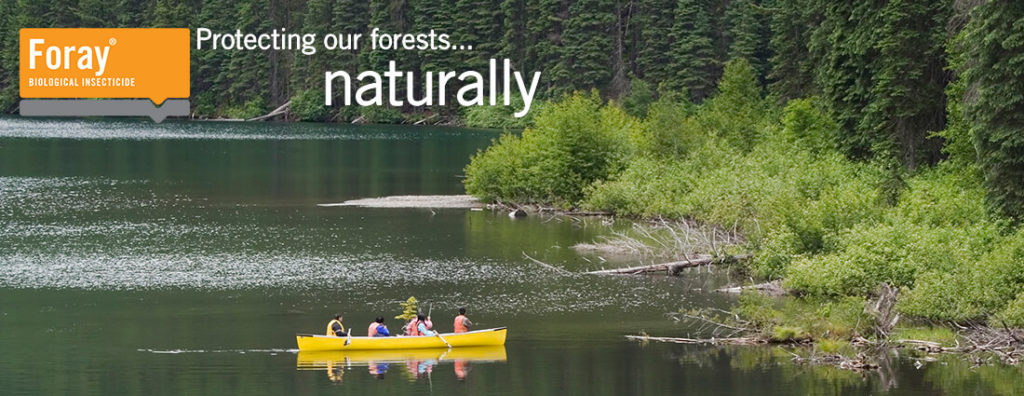Formulations
Products
Quick Links
Contact a Valent BioSciences public health representative.
Contact Us
Foray® 76B is a high potency, aqueous suspension formulation of Bacillus thuringiensis subsp. kurstaki (Btk strain ABTS-351; potency of 16,700 Cabbage Looper Units [CLU] per milligram) that was specifically developed to protect forests from harmful defoliation caused by specific caterpillar pests. Btk is a unique, naturally occurring bacterium that affects only caterpillars and, because of the unique chemistry of the caterpillar’s gut, Foray 76B Btk is very selective in its activity. Foray 76B has minimal environmental impact and it will not harm other types of insects, fish, birds or mammals.

Caterpillars must ingest Foray 76B for it to be effective. When forest health professionals determine the timing is right, certified applicators apply Foray 76B to caterpillar-infested trees and forests. Shortly after Foray 76B is eaten, it causes a reaction in the caterpillar’s gut; the caterpillar quickly stops feeding, the gut ruptures, and the caterpillar dies within a day or two.
Foray 76B can be applied either neat (undiluted) or diluted with water depending on program needs and application criteria; it should always be applied according to label directions for best results. Timing of Foray 76B spray is critical as well as good spray coverage. As caterpillars do not hatch and develop all at the same time, sometimes a second application may be required. Foray 76B is more effective on younger caterpillars, so more than one application may be needed to control later emerging caterpillars. A second spray may also be required when caterpillar populations are extremely high. Various caterpillar species have varying levels of susceptibility to the Btk toxins; consequently there is a wide range of dosages identified on the label to ensure that effective control of the target species is obtained. (See below.)
Note: Foray 76B differs from Foray 48B in that Foray 76B was initially developed as a higher potency, more concentrated formulation, primarily used to control defoliators such as Budworms and Tussock Moths in coniferous forests. Foray 76B can be used to control lepidopteran defoliators in deciduous forests too, but caution must be taken to ensure that adequate atomization and foliar deposition occurs. Traditionally higher volumes (with slightly larger droplet sizes) are applied to control defoliators in deciduous forests
Suggested Rate Range for Control of Forest Pests (U.S. label rates are used as an example.) US and Canadian labels are included below (see Downloads); please contact your local supplier for an in-country label.
| Crop | Pest | Rate1(oz/acre) | Dosage1(CLU/acre) | Rate1(l/ha) | Dosage1(CLU/ha) |
| Forests, Shade Trees, Ornamentals, Shrubs, Sugar Maple Trees, Orgnamental Fruit, Nut & Citrus Trees2 | Spongy Moth Elm Spanworm | 13.5 – 67.5 | 8 – 40 | 1. 0 – 4.9 | 20 – 99 |
| Spruce Budworm Browntail Moth Douglas Fir Tussock Moth Coneworm Buck Moth | 13.5 – 50.5 | 8 – 30 | 1.0 – 3.7 | 20 – 74 | |
| Tussock Moth Pine Butterfly Bagworm Leafroller Tortrix Mimosa Webworm Tent Caterpillar Jackpine Budworm Blackheaded Budworm Saddled Prominent Saddleback Caterpillar Eastern & Western Hemlock Looper Organgestriped Oakworm Satin Moth | 10.0 – 27.0 | 6 – 16 | 0.7 – 2.0 | 15 – 40 | |
| Redhumped Caterpillar Spring & Fall Cankerworm California Oakworm Fall Webworm | 7.0 – 13.5 | 4 – 8 | 0.5 – 1.0 | 10 – 20 |
Special Instructions
1. Use the higher recommended rates on advanced larval stages or under high density larval populations.
2. In treating Spongy Moth infested trees and shrubs in urban, rural, and semi-rural areas, exposure of non-target vegetation including, but not limited to, native and ornamental species and food or feed crops is permitted.
Resources
Learn more about Foray® 76B
Quick Links
Contact a Valent BioSciences public health representative.
Contact Us

